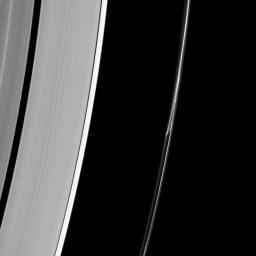
|
Splitting the F Ring
- Click the image above for a larger view
- Full-Res JPEG (1016 x 1016) (46.7 kB)
- Full-Res TIFF (1016 x 1016) (1.0 MB)
Caption:
Saturn's F ring often appears to do things other rings don't. In this Cassini spacecraft image, a strand of ring appears to separate from the core of the ring as if pulled apart by mysterious forces.
Some ring scientists believe that this feature may be due to repeated collisions between the F ring and a single small object.
Eight stars are also visible in this image.
This view looks toward the unilluminated side of the rings from about 49 degrees below the ringplane. The image was taken in visible light with the Cassini spacecraft narrow-angle camera on Oct. 19, 2013.
The view was obtained at a distance of approximately 1.2 million miles (1.9 million kilometers) from Saturn and at a Sun-Saturn-spacecraft, or phase, angle of 120 degrees. Image scale is 6.8 miles (11 kilometers) per pixel.
Background Info:
The Cassini-Huygens mission is a cooperative project of NASA, the European Space Agency and the Italian Space Agency. The Jet Propulsion Laboratory, a division of the California Institute of Technology in Pasadena, manages the mission for NASA's Science Mission Directorate, Washington, D.C. The Cassini orbiter and its two onboard cameras were designed, developed and assembled at JPL. The imaging operations center is based at the Space Science Institute in Boulder, Colo.
For more information about the Cassini-Huygens mission visit http://saturn.jpl.nasa.gov and http://www.nasa.gov/cassini . The Cassini imaging team homepage is at http://ciclops.org .
Cataloging Keywords:
| Name | Value | Additional Values |
|---|---|---|
| Target | Saturn Rings | F Ring, Saturn |
| System | Saturn | |
| Target Type | Ring | Planet |
| Mission | Cassini-Huygens | |
| Instrument Host | Cassini Orbiter | |
| Host Type | Orbiter | |
| Instrument | Imaging Science Subsystem (ISS) | |
| Detector | Narrow Angle Camera | |
| Extra Keywords | Collision, Grayscale, Visual | |
| Acquisition Date | ||
| Release Date | 2014-02-10 | |
| Date in Caption | 2013-10-19 | |
| Image Credit | NASA/JPL-Caltech/Space Science Institute | |
| Source | photojournal.jpl.nasa.gov/catalog/PIA17148 | |
| Identifier | PIA17148 | |
